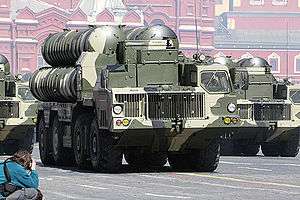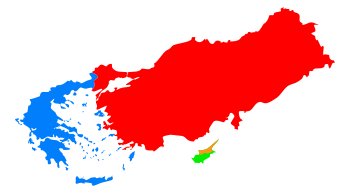Cyprus Missile Crisis
The Cyprus Missile Crisis came to worldwide media attention between early 1997 and late 1998 as a tense and rapidly escalating political standoff between the Republic of Cyprus and the Republic of Turkey. The confrontation was sparked by Cypriot plans to install two Russian-made S-300 air-defence missile sites on their territory, provoking Turkey into threatening an attack or even all-out war if the missiles were not returned to Russia. The missiles deal with Russia represented the Cyprus government's first serious attempt at building a credible air defence system after all the years of Turkish superiority in the air.[1] The crisis effectively ended in December 1998 with the decision of the Cypriot government to transfer the S-300s to Greece's Hellenic Air Force in exchange for alternative weapons from Greece. Also, the crisis led to the collapse of coalition government in Cyprus.[2] Greece's Hellenic Air Force installed the system on the island of Crete and as of 2016 the S-300s still operate there.
Prelude to the crisis
As of 1995, the Cypriot government had reportedly begun conceptualisation and planning of an integrated air-defence solution to defend the airspace of the Republic of Cyprus, which according to local press reports, was sustaining near daily airspace violations by the Turkish Air Force. Also, the recent sale of ATACMS long-range artillery rockets to Turkey were perceived as a threat by the Cypriots, which evidently determined that it had no means of defence, should these weapons be fired from the southern Turkish coast into the unoccupied areas of the Republic of Cyprus.
On 3 January 1997, an unnamed defence source leaked information to the Cypriot media regarding the purchase of Russian-made surface-to-air missiles, the story was picked up by Reuters[3] and the Cyprus News Agency,[4] amongst others. The leak reported that the date for the conclusion of the sale between Russia and Cyprus for surface-to-air missile systems would be 4 January 1997.[4]
On 5 January 1997, Cypriot Foreign Minister Alekos Michaelides announced to the world media that the government had acquired an air-defence capability in the form of Russian-made S-300 air-defence missiles and associated radars. At this stage, details were kept vague, and the media seized upon rumours, ranging from claimed numbers of missiles and capability, to wildly differing claims of the price for the purchase.
On the same day, government spokesman Yiannakis Cassoulides made a statement in which he remarked that the Cyprus government had the "legitimate right to enhance its "defence capabilities", and also said that the weapons purchase was "proportional" to the Turkish military build-up in the north of the island. Concurrently, Turkish Defence Minister Turhan Tayan was reported in Turkey as saying that the action would "undermine peace in the region". [5]
Russia's main defence export agency, Rosvooruzheniye, also added its comment to the media frenzy, when spokesman Valery Pogrebenkov stated that the sale of S-300 missiles to Cyprus would not adversely affect the balance of power in the region, as the weapons were "purely defensive".[6]
Cypriot S-300 missile capability

Although never publicly revealed in exact detail and widely debated, many observers have concurred that the Cypriot government acquired two batteries of S-300PMU-1s, each consisting of at least one 64N6E (BIG BIRD D) early-warning and battle management radar, and a minimum of four 5P85TE towed quadruple launchers and sixteen 48N6 missiles. These missiles would have had a maximum range of 150 km. Other equipment likely to have been provisioned in the purchase (based upon standard deployment practice for this type of weapon array), would have included the 83M6E command and control system, as well as support radar infrastructure and mobile engineer support vehicles.
The primary evidence for such a combat capability has come from gradual disclosure to the media of S-300PMU-1 capabilities in Crete following the 1998 deployment of the weapons to the Greek island. Also, digital aerial and satellite photography, such as that presented by Google Earth, has allowed independent observers to suggest that at least three new military facilities were purpose-built in Cyprus for the deployment of the S-300s (two sites for the missile batteries, and one mountain site for the 64N6E radar package). According to some of these observers, the radar site and one of the missile sites were installed in heavily fortified positions on the northern face of Mount Olympus, the largest mountain in the Troodos range. Additionally, a second fortified missile site is claimed to exist in the vicinity of Droushia, a coastal village in the extreme west of the island.[7]
Turkish reaction
On 11 January 1997, Cypriot and US media sources reported that Turkey had overtly threatened either a pre-emptive strike to prevent the arrival of the missiles, or an actual war on Cyprus as a response to the arrival of the missiles. Also, it threatened about a blockade of Cyprus from Turkey.[8]
Turkey also said it might occupy an abandoned tourist resort in Cyprus if the Cypriot government didn't back down.[9] The Turkish Cypriot leader, Rauf Denktash, threatened to take over Varosha, a disputed area that has been sealed off since Turkey's 1974 invasion of Cyprus. Most property in Varosha, is owned by Greek Cypriots.[10]
The Turkish armed forces, when the purchase of S-300 was announced, obtained from Israel surface-to-surface missiles, which could be used in a military operation to destroy the S-300 when they would be installed on the island.[11] Also, according to Turkish media and intelligence agencies of other countries, Turkish pilots with their F-16s sent to Israel at Negev in order to be trained on how to destroy the S-300s.[12] According to Israel radio reports Turkish pilots trained only on how to dodge the S-300s and not how to destroy them.[13] While the Israel embassy at Athens denied all the reports.[14]
On November 1997, Turkish armed forces carried out a military exercise, at Northern Cyprus, at which they destroyed S-300 dummy missiles in order to be ready for operation against the real missiles at Cyprus.[15]
Cypriot, Greek and Russian counter-reactions
Cypriot Government protested against the Turkish threats at the UN, asserting its right for self-defense and the need for effective deterrence.[16] In addition, Cyprus President Glafcos Clerides said that the missiles will be deployed on the island but will be used only defensively.[17] Also, the Cypriot armed forces were placed at their highest state of alert and mobilisation since the 1974 invasion of the island by Turkey.
Between January and June 1997, Greece reportedly increased the readiness of its Air Force and Navy assets positioned closest to Cyprus, and moved to tacitly support the Cypriot position that the missiles were designed for defensive uses only. The situation was then escalated, this time by the Greek decision to send a small contingent of F-16 fighter jets to Cyprus, as well as additional troops to reinforce the Greek ELDYK contingent on the island.
Russia initially avoided direct confrontation with Turkey, but insisted repeatedly that the sale of S-300s to Cyprus would proceed without interference. Turkey consequently looked to her strategic NATO partners, including the United States for reassurances that she would not be prevented from acting against the perceived threat, should the need arise.
Further escalation
Over the following months leading up to June 1997, the two sides traded political rhetoric and aggressive propaganda as both attempted to justify their positions before the international community.
In September 1997, the Turkish Navy and Coastguard began to board and search vessels heading to Cyprus, including Russian-flagged vessels in international waters. The situation alarmed not only the Cypriots, but their strategic military and economic partners in Athens and Moscow, evidenced by official statements in October 1997 indicating that Greece and Russia would engage in war with Turkey if Cyprus was attacked or blockaded.
By December, reports began to surface in Greece and Cypriot media forums that Russia was in the process of mobilising a large naval force which would include an aircraft carrier with long-range warplanes, a guided-missile cruiser and attack submarines. The presumption was that this force would have two purposes – to transport S-300 missiles and other military articles via Greek waters to Cyprus, and secondly, to destroy the Turkish Navy should it try to intervene.
Defusing the Crisis
Greek Cypriots have raised the possibility of canceling the missile deployment in exchange for a U.S.-enforced flight moratorium over Cyprus, but Turkey rejected it.[18]
Rather than face the political prospect of humiliation by conceding to Turkish demands that the sale be cancelled outright, President Glavkos Clerides finally decided in December 1998 that the S-300 missile systems would be sent to Crete. Ostensibly, the decision was made to ensure that the deal with Russia proceeded to the latter’s economic benefit, and that Greece was compensated for the situation by receiving the defensive capability of the S-300s for Crete. The Turkish government decried the move as a "cynical attempt" to redirect the S-300 missile capability against her south-western shores and airspace, while giving much-desired air-defence for Greek ships and aircraft heading from Crete to Cyprus.[19]
The crisis, also, led to the collapse of coalition government in Cyprus.[20]
Cypriot agreement with Greece
The Cypriot government never again seriously entertained the return of the S-300 air-defence missile systems to Cyprus, for fear of unnecessarily damaging her reputation and position in European political circles. Consequently, in 2007, the missiles were finally and irrevocably sold to Greece in exchange for alternative military articles, reputed to consist of a significant quantity of short-range TOR-M1 missile systems, and an undisclosed type of medium-range air-defence missile systems. Greece also voluntarily supplied Cyprus with twelve self-propelled 155mm artillery howitzers as partial rental payment for the use of the S-300s between 1999 and 2006.[21]
Missile testing
On December 13, 2013, and for the first time since the missile system was acquired, it was tested in Crete.[22] The launch was carried out as part of the White Eagle 2013 military exercise and was described as “successful.”[23]
References
- ↑ "Turkey hints at strike on Cypriot missiles". independent.
- ↑ Cyprus transfers controversial S300 missiles to Greece
- ↑ "Cyprus close to buying Russian missiles", Fri, 3 Jan 1997, Reuters
- 1 2 "Cyprus to buy Russian surface-to-air missiles" on 4 Jan 1997 by CYPRUS NEWS AGENCY
- ↑ "Cyprus missile buy could shift military balance" on Sun, 5 Jan 1997 by Michele Kambas, Reuters
- ↑ "Russian arms exporter hails Cyprus missile deal on Sun", 5 Jan 1999 by Andrei Shukshin for Reuters
- ↑ http://geimint.blogspot.com/2008/05/cypriot-missile-crisis.html. Accessed 30/02/10
- ↑ "Turkey hints at strike on Cypriot missiles". independent.
- ↑ "Missile dispute threatens Cyprus truce". cnn.
- ↑ "Turkey hints at strike on Cypriot missiles". independent.
- ↑ "Τρία σενάρια για τους S-300" (in gr). tovima.
- ↑ "Τρία σενάρια για τους S-300" (in gr). tovima.
- ↑ "Turkey hints at strike on Cypriot missiles" (in gr). tovima.
- ↑ "Τρία σενάρια για τους S-300" (in gr). tovima.
- ↑ "Πρώτη δοκιμή S-300 στην Κρήτη" (in gr). enet.
- ↑ Stürchler, Nikolas (September 2009). The Threat of Force in International Law. Cambridge University Press. p. 147. ISBN 978-0521133616.
- ↑ TURKEY: TANSU CILLER CYPRUS MISSILE CRISIS INTERVIEW
- ↑ Defusing the Missile Crisis in the Aegean
- ↑ "Clerides is distorting history" in Cyprus Mail, by Elias Hazou, 5 May 2007
- ↑ Cyprus transfers controversial S300 missiles to Greece
- ↑ "Cyprus hands S300s to Greece in arms swap" in Cyprus Mail, Jean Christou, 19 December 2007
- ↑ http://theaviationist.com/2014/01/12/greece-fires-s300/
- ↑ http://sputniknews.com/russia/20131214/185536376/Greece-Tests-Russian-Made-S-300-Missile-System-for-First-Time.html
